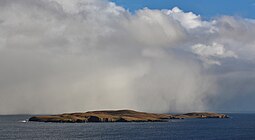| Old Norse name | Mósey (Norwegian: Mosøy) |
|---|---|
| Meaning of name | Old Norse: moor or mossy island[1] |
 A snow shower over Mousa | |
| Location | |
| OS grid reference | HU460240 |
| Coordinates | 60°00′N 1°10′W / 60.00°N 1.17°W |
| Physical geography | |
| Island group | Shetland |
| Area | 180 hectares (0.69 sq mi)[1] |
| Area rank | 115= [2] |
| Highest elevation | 55 metres (180 ft)[1] |
| Administration | |
| Council area | Shetland Islands |
| Country | Scotland |
| Sovereign state | United Kingdom |
| Demographics | |
| Population | 0 |
| References | [3][4] |
Mousa /ˈmuːsə/ (Old Norse: Mosey "moss island") is a small island in Shetland, Scotland, uninhabited since the nineteenth century. The island is known for the Broch of Mousa, an Iron Age round tower, and is designated as a Special Protection Area for storm-petrel breeding colonies.
- ^ a b c Haswell-Smith, Hamish (2004). The Scottish Islands. Edinburgh: Canongate. pp. 411–14. ISBN 978-1-84195-454-7.
- ^ Area and population ranks: there are c. 300 islands over 20 ha in extent and 93 permanently inhabited islands were listed in the 2011 census.
- ^ Ordnance Survey. OS Maps Online (Map). 1:25,000. Leisure.
- ^ Anderson, Joseph (Ed.) (1893) Orkneyinga Saga. Translated by Jón A. Hjaltalin & Gilbert Goudie. Edinburgh. James Thin and Mercat Press (1990 reprint). ISBN 0-901824-25-9
